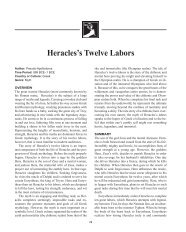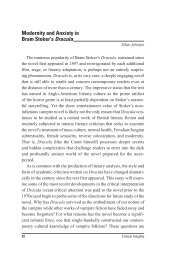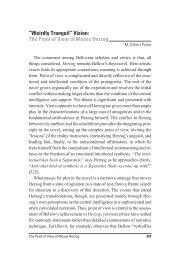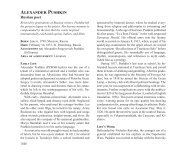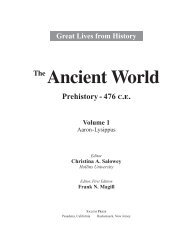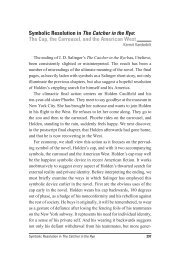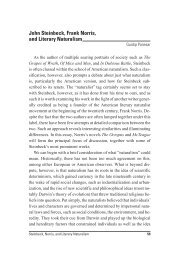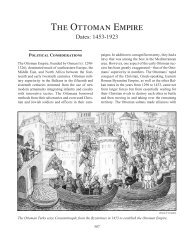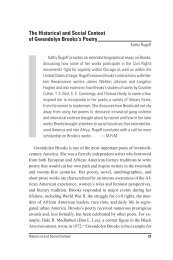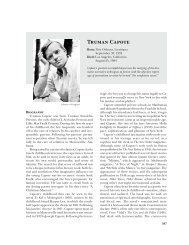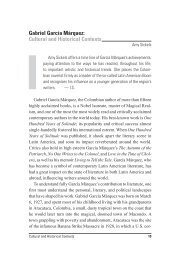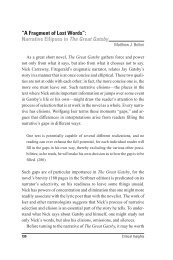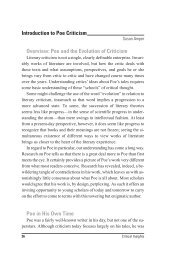You also want an ePaper? Increase the reach of your titles
YUMPU automatically turns print PDFs into web optimized ePapers that Google loves.
Critical Survey of Poetry Nemerov, Howard<br />
closest to being an intercessor between God and man,<br />
and this link is the theme of Sentences. Here Nemerov<br />
applies his belief that “in the highest range the theory of<br />
poetry would be the theory of the Incarnation, which<br />
seeks to explain how the Word became Flesh.” In a letter<br />
to Robert D. Harvey, he wrote,<br />
Poetry is a kind of spiritual exercise,<br />
a (generally doomed but stoical) attempt<br />
to pray one’s humanity back into the universe;<br />
and conversely an attempt to read, to derive anew,<br />
one’s humanity from nature ...Inthedarkness<br />
of this search, patience and good humour are<br />
useful qualities. Also: the serious and the funny<br />
are one. The purpose of poetry is to persuade,<br />
fool or compel God into speaking.<br />
Indeed, the main theme of Sentences is the coherence<br />
art gives to life’s randomness. In accordance with his<br />
theory of connecting through the power of art, the book<br />
is divided into sections titled “Beneath,” “Above,” and<br />
“Beyond”; these sections correspond to sex and power<br />
(beneath), metaphysics and poetry (above), and human<br />
destiny (beyond). The first section is ironic, the middle<br />
is speculative, and the last is moving. Critics generally<br />
disliked the first part of Sentences, but applauded the<br />
other two sections.<br />
Inside the Onion and War Stories<br />
After Sentences, Nemerov published another stunning<br />
poetry collection, Inside the Onion. The title wryly<br />
implies his subjective-objective, romantic-realist nature.<br />
In this book Nemerov blends the homely and the humorous<br />
into poems that avoid the dramatic and highlight the<br />
commonplace, making it arresting.<br />
War Stories contains forty-six poems grouped into<br />
three parts: “The War in the Streets,” “The War in the<br />
Air,” and “The War in the Heavens.” This volume is<br />
Nemerov at his metaphysical best, grounding his spiritual<br />
musings in everyday experience. His interest in science<br />
and modern events is linked to literature—for example,<br />
the advent of Halley’s Comet is hailed in the<br />
language of the speech in the Anglo-Saxon epic Beowulf<br />
that compares man’s life to a swallow’s brief flight<br />
through a mead hall. These poems range from an elegy<br />
for a student to explorations of subtle psychological insights<br />
to profound spiritual observations: “Though God<br />
be dead, he lived so far away/ His sourceless light continues<br />
to fall on us” (“The Celestial Emperor”).<br />
Other major works<br />
long fiction: The Melodramatists, 1949; Federigo:<br />
Or, The Power of Love, 1954; The Homecoming<br />
Game, 1957.<br />
short fiction: A Commodity of Dreams and<br />
Other Stories, 1959; Stories, Fables, and Other Diversions,<br />
1971.<br />
nonfiction: Poetry and Fiction: Essays, 1963;<br />
Journal of the Fictive Life, 1965; Reflexions on Poetry<br />
and Poetics, 1972; Figures of Thought: Speculations<br />
on the Meaning of Poetry and Other Essays,<br />
1978; New and Selected Essays, 1985; The Oak in<br />
the Acorn: On “Remembrance of Things Past” and<br />
on Teaching Proust, Who Will Never Learn, 1987.<br />
edited text: Poets on Poetry, 1965.<br />
miscellaneous: A Howard Nemerov Reader, 1991.<br />
Bibliography<br />
Bartholomay, Julia A. The Shield of Perseus: The Vision<br />
and Imagination of Howard Nemerov. Gainesville:<br />
University of Florida <strong>Press</strong>, 1972. This book discusses<br />
Nemerov’s use of multivalent images and<br />
other poetic techniques, and his poetry’s recurrent<br />
themes. There is detailed information about the poet<br />
drawn from his letters and conversations. For the<br />
reader seeking a hypothesis about Nemerov’s “religious”<br />
outlook and a careful examination of his artistic<br />
techniques, this book is an excellent source.<br />
Knock, Stanley F., Jr. “Renewal of Illusion.” The Christian<br />
Century. January 16, 1962, 85-86. In this review<br />
of Nemerov’s verse drama Endor, Knock shows how<br />
Nemerov transports an Old Testament story into the<br />
context of existentialism and the Cold War. Rather<br />
than “see ourselves as others see us,” as Robert<br />
Burns advised, Nemerov finds hope not in the stripping<br />
of illusion, but in its renewal.<br />
Meinke, Peter. Howard Nemerov. Minneapolis: University<br />
of Minnesota <strong>Press</strong>, 1968. One of the most comprehensive<br />
books on Nemerov insofar as general<br />
knowledge is concerned. It covers not only biographical<br />
data but also the effect some life incidents<br />
had on his work. There are brief comments on Nem-<br />
2753



